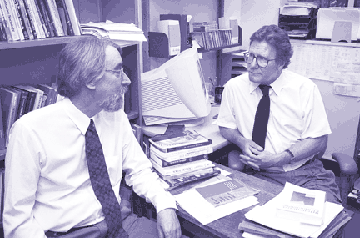|
In traditional AIDS prevention programs, professional outreach workers inform injecting drug users (IDUs) about drug-related and sexual behaviors that can lead to HIV infection. NIDA-supported research is demonstrating that recruiting IDUs to help disseminate this information may be a way to reach more drug users and reduce their risky behaviors.
Dr. Robert Broadhead, Dr. Douglas Heckathorn, and their colleagues at the University of Connecticut in Storrs recruited IDUs in Middletown, Connecticut, to educate their peers about reducing the spread of HIV and give them HIV prevention materials, such as condoms and bleach for cleaning their syringes. The IDU recruiters also encouraged their peers to visit a storefront office where they would be tested for HIV and learn more about how to reduce their risk of contracting AIDS.
At the storefront, program staff gave IDUs a brief AIDS prevention quiz to determine how well the IDU recruiter had educated them in the community. The staff also interviewed IDUs about their HIV risk behaviors, counseled them about how to reduce these behaviors, and tested them for HIV. Each IDU was given the opportunity to recruit and educate three peers for compensation. These IDUs, in turn, were given the opportunity to recruit and educate still more peers. Thus the number of recruits grew rapidly.
 Dr. Douglas Heckathorn (left), Dr. Robert Broadhead, and their colleagues found that injecting drug users (IDUs) educated about HIV risk reduction by peers shared injection paraphernalia and injected drugs less often than did IDUs educated traditionally.
|
The researchers compared the effectiveness of this approach, called peer-driven intervention, with the more common approach involving outreach workers, called traditional outreach intervention. In the traditional approach, three salaried outreach workers in Windham, Connecticut, were instructed to recruit new IDUs, educate them about AIDS prevention, and encourage them to visit a storefront in Windham. Frequently, traditional outreach workers are former drug users from the neighborhood. When the IDUs came to the storefront, they received the same intervention as the IDUs in Middletown, except that they were not given the opportunity to recruit their peers.
Over a 2-year period, the researchers found that the peer-driven intervention recruited 317 IDUs, 36 percent more than the 233 recruited in the traditional approach. The IDUs recruited by peers were more representative of the racial and ethnic composition of the community. The peer-driven intervention was also more effective in reducing HIV risk behaviors. In initial interviews with recruits and in followup interviews 6 months later, the researchers found that IDUs recruited by peers shared syringes and other injection paraphernalia less often and injected drugs substantially less often than did the IDUs recruited traditionally. The peer-recruited IDUs also scored higher on the AIDS prevention quiz administered when they first visited the storefront. In addition, the researchers determined that educating IDUs in the community was much less expensive in the peer-driven intervention than in the traditional outreach.
One reason the peer-driven approach was more effective was that participant IDUs were exposed more often to HIV prevention information than in the traditional approach, says Dr. Broadhead. In the peer-driven intervention, IDUs were first educated by peer recruiters on the street, then again by program staff at the storefront. This information was reinforced three more times when the recruits educated and recruited three of their peers. Finally, the IDU recruiters were exposed to the information again when they came to collect their compensation for educating and recruiting their peers. In contrast, IDUs recruited in the traditional intervention received only two exposures-once when they were recruited on the street and then again when they visited the storefront.
About 40 percent of the IDUs in the peer-driven approach became active recruiters, says Dr. Broadhead. "We stopped paying them after three recruits, but some of them continued to bring in their peers even though they knew they weren't going to get paid for it," he says. He also reports that some recruiter IDUs called the storefront to speak to health educators to make sure that they were passing on correct information.
Active IDUs are more effective in recruiting and educating other drug users because the latter are more likely to listen to people whom they consider to be like themselves, Dr. Broadhead says. Active drug users may view professional outreach workers with suspicion, even if the outreach workers are former drug users, he says.
Dr. Broadhead suggests that using both IDUs and traditional outreach workers works well because the IDUs are more effective at education and recruitment in the community, while traditional outreach workers are better prepared for tasks such as interviewing, case management, and referrals to community agencies.
Outreach Boosts Peer Leaders' Self-Image
In a related study, Dr. Carl Latkin at The Johns Hopkins University in Baltimore also used current IDUs to provide AIDS prevention information to drug users in the community. In Dr. Latkin's study, the IDUs who conducted AIDS outreach were recommended by their peers. Drug users who volunteered for the study were asked to recommend other drugs users in the community who might be effective communicators of AIDS prevention information. These peer leaders were then invited to attend 10 training sessions, for which they were compensated. After the fourth session, the leaders began their outreach activities, for which they were not compensated.
At the end of 3 months, the researchers interviewed peer leaders and IDUs who used drugs and engaged in sexual relations with one another. The HIV-related behaviors of the peer leaders and their IDU contacts were compared to the self-reported behaviors of IDUs who received standard HIV testing and counseling from outreach workers, and the behaviors of the peer leaders were compared to their own behaviors at the beginning of the study. The scientists found that both the peer leaders and their IDU contacts were more likely to clean their syringe needles with bleach before either injecting themselves or sharing the syringe with others. Also, the leaders reported significantly more use of condoms.
 Dr. Carl Latkin (left) and ethnographer James Peterson in the Baltimore neighborhood where they enlisted the help of injecting drug users to reduce the spread of HIV in the drug-using community.
|
In the training sessions, the leaders discussed how their attitudes toward the program changed as it progressed. Initially, they viewed AIDS outreach as theoretically important but they were not enthusiastic about engaging in the program. However, once they started their outreach activities and began to receive positive feedback from the community, they developed a higher regard for the program.
"Most of these people have had very few prosocial roles in their lives," says Dr. Latkin. "Consequently, giving them a prosocial role that people in the community respect and consider beneficial is a powerful motivator."
Because drug users began to view the peer leaders as experts, they started asking them about matters other than HIV prevention, such as how to get treatment for AIDS or drug addiction and how to get food, shelter, and other necessities. To help the peer leaders meet these requests, Dr. Latkin and his colleagues prepared information about health and social service agencies that peer leaders could hand out.
A surprising result of the study was the increase in condom use reported by the peer leaders. Studies have consistently found that reducing risky sexual behaviors is much more difficult than reducing risky drug-taking behaviors. Peer leaders may have increased their condom use because they wanted to live up to their new status as role models, Dr. Latkin speculates. "Also, I think that talking about condoms and carrying them around may have made them more comfortable with condoms," he says.
Complementary Approaches
Enlisting current drug users to perform AIDS outreach may be an effective way to reach some subgroups of the drug-using population not reached by
traditional outreach workers, says Dr. Richard Needle of NIDA's Center on AIDS and Other Medical Consequences of Drug Abuse. "I think that if you are conducting an AIDS outreach project, you might want a combination of outreach workers-some of whom are current users and some of whom are not," he says. He also thinks that Dr. Broadhead's and Dr. Latkin's studies should be tested in other communities to see whether their results can be replicated.
"NIDA is interested in exploring a range of outreach strategies and trying to determine the advantages and disadvantages of each of them," says Dr. Needle. "I suspect that the different approaches will prove to be complementary."
Sources
Broadhead, R.S., et al. Harnessing peer networks as an instrument for AIDS prevention: Results from a peer-driven intervention. Public Health Reports 113(Suppl. 1): 42-57, 1998.
Latkin, C. A. Outreach in natural settings: The use of peer leaders for HIV prevention among injecting drug users' networks. Public Health Reports 113(Suppl. 1):151-159, 1998.
Needle, R.H., et al. HIV prevention with drug-using populations-current status and future prospects: Introduction and overview. Public Health Reports 113(Suppl. 1):4-18, 1998.
Coyle, S.L.; Needle, R.H.; and Normand, J. Outreach-based HIV prevention for injecting drug users: A review of published outcome data. Public Health Reports 113(Suppl. 1):19-31, 1998.
|